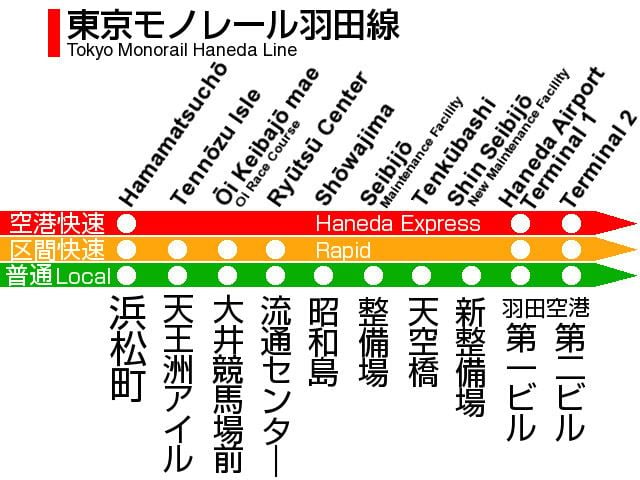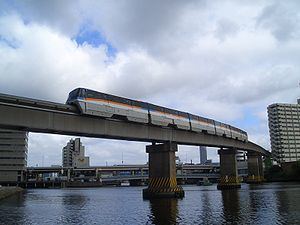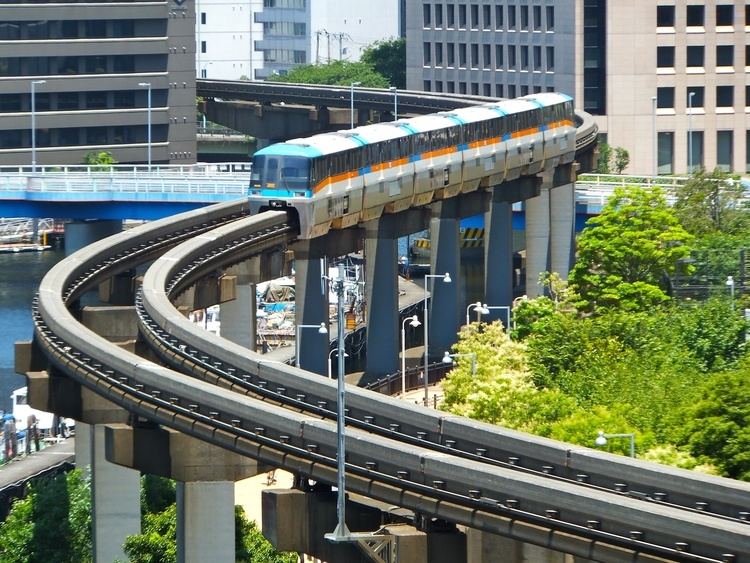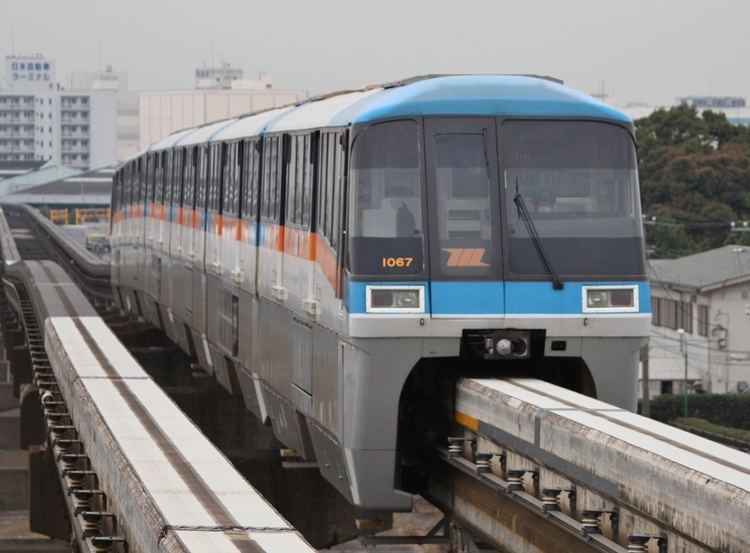Transit type Straddle-beam monorail Began operation September 17, 1964 Number of stations 11 | System length 17.8 km (11.1 mi) Locale Tokyo Number of lines 1 | |
 | ||
Daily ridership 311,856 (FY2010, weekdays) Operator(s) Tokyo Monorail Co., Ltd. Headway 3 min 20 sec. (peak), 4 min (off peak) Profiles | ||
Tokyo monorail
Tokyo Monorail (東京モノレール, Tōkyō Monorēru), officially the Tokyo Monorail Haneda Airport Line (東京モノレール羽田空港線, Tōkyō Monorēru Haneda Kūkō sen), is a monorail system connecting Haneda Airport in Ōta, Tokyo, Japan, to Monorail Hamamatsuchō Station in Minato, Tokyo. The trains operate along an elevated line that follows the coast of Tokyo Bay.
Contents
- Tokyo monorail
- tokyo international airport haneda airport 2 go to the tokyo downtown area by tokyo monorail
- Service patterns and stations
- Key
- Airport access
- Rolling stock
- Former rolling stock
- Ticketing and operating hours
- History
- Future extensions
- References
tokyo international airport haneda airport 2 go to the tokyo downtown area by tokyo monorail
Service patterns and stations
The following three different train service types operate on the line.
Haneda Express trains make the non-stop run between Monorail Hamamatsuchō and Haneda Airport in 13 minutes.
Key
● Stops at this station
| Does not stop at this station
Airport access

Passengers using the monorail to travel to the airport can take advantage of check-in facilities at Hamamatsuchō. Japan's domestic airlines (JAL, ANA, Skymark Airlines, and Air Do) have check-in counters and ticket machines right at the station. Tokyo Monorail tickets can also be purchased on the lower level of Kansai International Airport in Osaka, Itami Airport (also in Osaka), as well as Naha Airport in Okinawa and departure gate area at Hiroshima Airport.

An alternative to the monorail is the Keikyu Airport Line between the airport and Shinagawa Station. Both railways compete with the bus services.
Rolling stock

Services are operated using six-car 1000 and 2000 series trains, running at speeds of up to 80 km/h (50 mph). Each car has a combination of aisle-facing bench seats, forward and rear-facing seats, and seats in the center of the aisle. The trains also feature extra space for hand luggage, as a convenience for air travelers. These trains are stored and maintained at Shōwajima Depot beside Shōwajima Station during off-service hours. The 1000 series trains were introduced from 1989, and the 2000 series trains were introduced from 1997.

From 18 July 2014, the first of a fleet of new 10000 series 6-car trains was introduced, replacing the older 1000 series trains.
Former rolling stock

Former rolling stock once used on Tokyo Monorail include the 100/200/300/350 series (from 1964 until 1978), 500 series (from 1969 until 1991), 600 series (from 1977 until 1997), and 700/800 series (from 1982 until 1998).
Ticketing and operating hours
Tokyo Monorail was originally one of the only "private" railways to use JR East's Suica fare card system. The Monorail is now fully integrated with both Suica and the new Pasmo fare card.
The first departure towards the airport leaves at 04:58 and the last departure is at 00:01. Towards Hamamatsuchō, the first departure is at 05:11 and the final departure is at 00:05 (final departure serving all stations at 23:38).
History
The line was originally planned to extend from Haneda to Shimbashi or Tokyo Stations and the monorail company acquired licences to build the line to both locations. However, cost overruns on the Tōkaidō Shinkansen drained the government subsidies allocated to the construction of both lines, requiring the Tokyo Monorail to shorten its route. In addition, to save costs the monorail was constructed over public waterways instead of acquiring private land for the route. The resulting construction eliminated a number of fishing and aquatic farming operations and the affected local fishing cooperatives had their licences summarily revoked by the Tokyo metropolitan government. In particular, the Omori no nori sea field in Ota Ward, which had produced a premium brand of nori since the Edo Period, was destroyed.
The line opened on 17 September 1964, ahead of the 1964 Summer Olympics. Built by Hitachi Monorail, the first cars were made in Japan from the German ALWEG design (also used in the Seattle Center Monorail and the original Disneyland Monorail), and were replaced by newer models in 1969, 1977, 1982, and 1989. It was the first commercial monorail in the world.
Originally, the monorail only served Hamamatsuchō and the airport. The first station added in between was the Ōi Race Track in 1965, followed by Seibijō in 1967.
When the monorail began operation, the passenger terminal at Haneda Airport was located on the west side of the airfield, south of Seibijō, and this was the southern terminus of the monorail. Upon the opening of the new passenger terminal (now Terminal 1) in 1993, the monorail was extended to a new platform, and the former passenger terminal was razed to make room for an extension of Runway B. The now-unused monorail tunnel leading to the old station was leased from the Transport Ministry and therefore had to be restored to its original state prior to its handover. Although the rails were removed from the tunnel and its entrance walled off, the tunnel remains otherwise intact today below the extension of Runway B.
A single-station, 0.9-km extension to Haneda's new Terminal 2 opened on December 1, 2004, and the opening of a passing loop at Showajima allowed express services from March 18, 2007. A new station to serve the airport's new International Terminal was opened on 21 October 2010.
The Tokyo Monorail serves eleven stations and operates from around 5:00 a.m. to midnight with over 500 trains. It carried its 1.5 billionth passenger on January 24, 2007.
The line is operated by the Tokyo Monorail Co., Ltd. (東京モノレール株式会社, Tōkyō Monorēru Kabushiki-gaisha). JR East purchased stock in the company in 2002, currently owning 70%; the remainder being divided between Hitachi (12%), Japan Airlines (9%), and All Nippon Airways (9%).
Future extensions
In June 2009, Tokyo Monorail Co., Ltd., formally notified the Ministry of Land, Infrastructure and Transport of its intent to convert the present single-track terminal at Hamamatsucho, which had rested unchanged since 1964, into a dual-track, dual-platform structure. To be built in six and a half years at an estimated cost of 26 billion yen, this would increase the line's capacity from 18 to 24 trains per hour and lay the groundwork for a long-mooted extension to Shimbashi Station. In August 2014, it was revealed that the line could be extended from Hamamatsucho to Tokyo Station, running alongside the Yamanote Line tracks between Shimbashi and Tokyo. Total costs are estimated at 109.5 billion yen, with construction taking approximately ten years.
